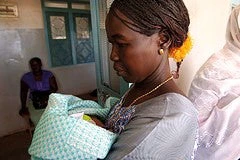
But I would say that the potential for this development may be undermined if the everyday tragedy of preventable maternal deaths continues unabated across the continent.
The recently-released report “Trends in Maternal Mortality: 1990 to 2010. WHO, UNICEF, UNFPA and The World Bank estimates” paints a dramatic picture. Overall, close to 60% of global maternal deaths occur in sub-Saharan Africa, and at 500 maternal deaths per 100,000 live births, the region has the highest maternal mortality ratio (MMR) in the world, well above Southern Asia (220), Oceania (200), South-eastern Asia (150), and Latin America and the Caribbean (80).
While Sierra Leone (890), the Central African Republic (890), Burundi (800), Guinea-Bissau (790), Liberia (770), the Sudan (730), Cameroon (690), and Nigeria (630) had very high MMRs, Chad and Somalia had extremely high MMRs at 1100 and 1000, respectively.
The data also show that for many sub-Saharan African countries it will be difficult and in some cases impossible to achieve the Millennium Development Goal (MDG) 5 target of reducing maternal mortality by 75% between 1990 and 2015. That is the case of countries such as Zambia (440) and Kenya (360) that show insufficient progress, or Zimbabwe (570) and South Africa (300), with no measurable progress over the last 20 years.
Although the MMR has started to decline in some countries, such as Botswana, Lesotho, Namibia, South Africa and Swaziland, due to the increased availability of antiretroviral drug therapy for HIV infected people, they are not expected to meet the MDG5 target. Equatorial Guinea, with an 81% reduction achieved by 2010, is the only African country that has already met the MDG 5 target.
The situation in the sub-Saharan countries was common in the United States, Australia, New Zealand, and continental Europe up to the late 1930s, when dramatic declines began to occur. This was due in large measure, according to a historical account by Irvine Loudon, to successive improvements in the quality of maternal care services, including the adoption of simple hygienic measures such as mandatory hand washing by doctors before patient examination and the use of antibiotics to prevent and control bacterial infections contracted by women during childbirth that were often fatal.
While vaccination, distribution of insecticide-treated bednets, vitamin A supplementation, and deworming, that help reduce child mortality, can be delivered according to a “predeterminate” schedule or “outside” health facilities, acute or emergency care services for dealing with pregnancy complications that in most cases cannot be predicted and prevented require a well organized and run health system.
So, if we heed the lessons from history, a renewed push needs to be placed on expanding the referral and emergency obstetric care capacity in the African health systems, including well trained, incentivized, and supervised teams of community health workers, midwives, nurses and doctors, to provide quality services to deal with direct obstetric complications, which occur around the time of childbirth and cause more than 60% of maternal deaths: hemorrhage, hypertensive disease, sepsis/infection, obstructed labor and other direct causes. Well funded and accessible voluntary family planning services would also contribute by reducing unwanted pregnancies and thus the risk of maternal death. And the development of accurate data systems is vital not only for keeping track of the number and causes of maternal deaths, but also for evidence-based policy-making and performance management and evaluation.
There are “demand” factors as well. Since care at the time of birth is crucial for saving mothers and newborns, reducing barriers that prevent pregnant women from going to health facilities, particularly in regions with poor road infrastructure, challenging terrain and limited transport options, cannot be ignored. Addressing these factors will require new approaches, such as innovative community transport schemes when ambulances are not available, alongside efforts at the community level to raise knowledge of maternal and newborn danger signs that often go ignored.
As the “African Century” evolves, sustained reductions in maternal deaths should be seen as a “critical marker” to gauge its progress and impact on improving the lot of society as a whole.
Resources:
- Trends in Maternal Mortality: 1990 to 2010. WHO, UNICEF, UNFPA and The World Bank estimates
- Maternal mortality in the past and its relevance to developing countries today”:


Join the Conversation